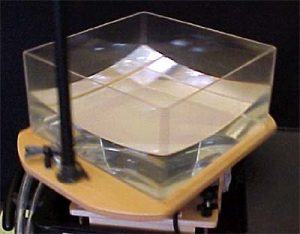We take our clear square 16” x 16” tank and position it on the center of the turntable. We fill it roughly half with water, set it turning and leave it until it comes in to solid body rotation, i.e., the state in which fluid parcels have zero velocity in the rotating frame of reference. This is easily determined by viewing a paper dot floating on the free surface from a co-rotating camera. Due to the relative motion of the water and the air above, solid body rotation can never be exactly achieved: there will always be some drift, particularly at higher rotation rates.
We note that the free-surface of the water is not flat; it is depressed in the middle and rises up to its highest point along the rim of the tank as can be seen in the photograph below. The degree to which the free surface deforms depends on the rate of rotation.
Have fun by turning up the speed of rotation to its maximum value. Considerable deformations can be achieved.
Experiment by dropping in potassium permanganate crystals – note that they do not fall vertically, but rather in a direction which is perpendicular to the (warped) free surface.
